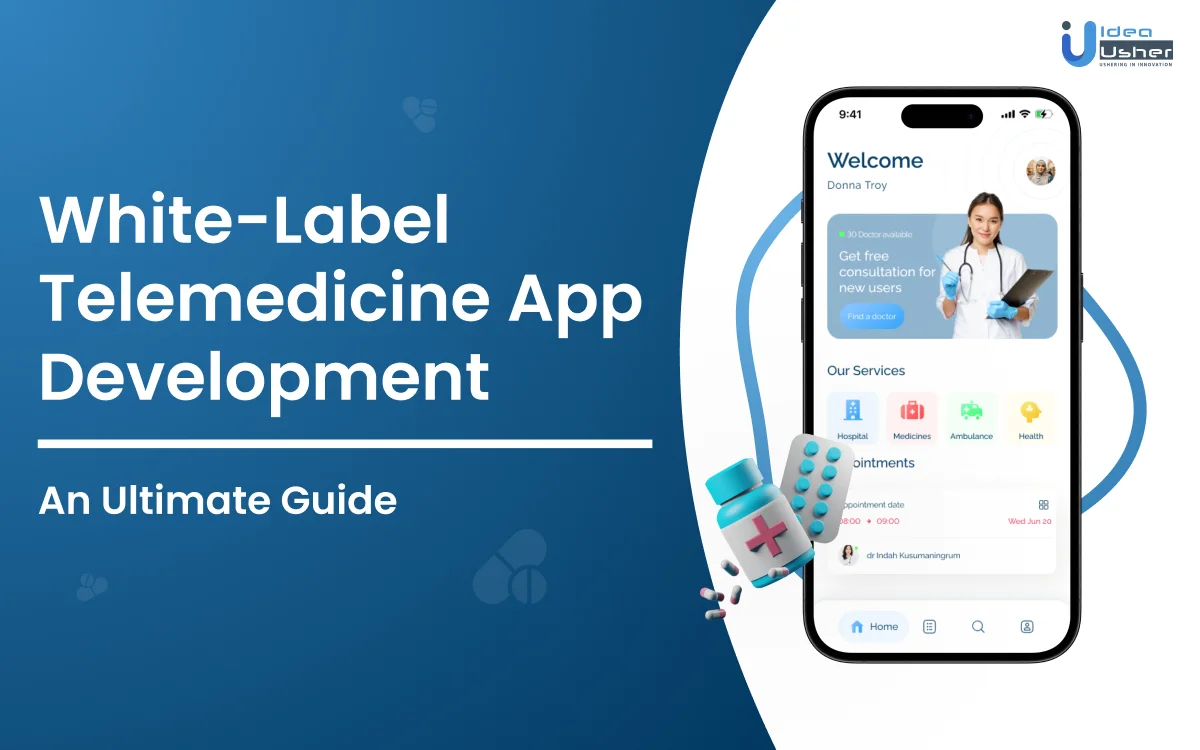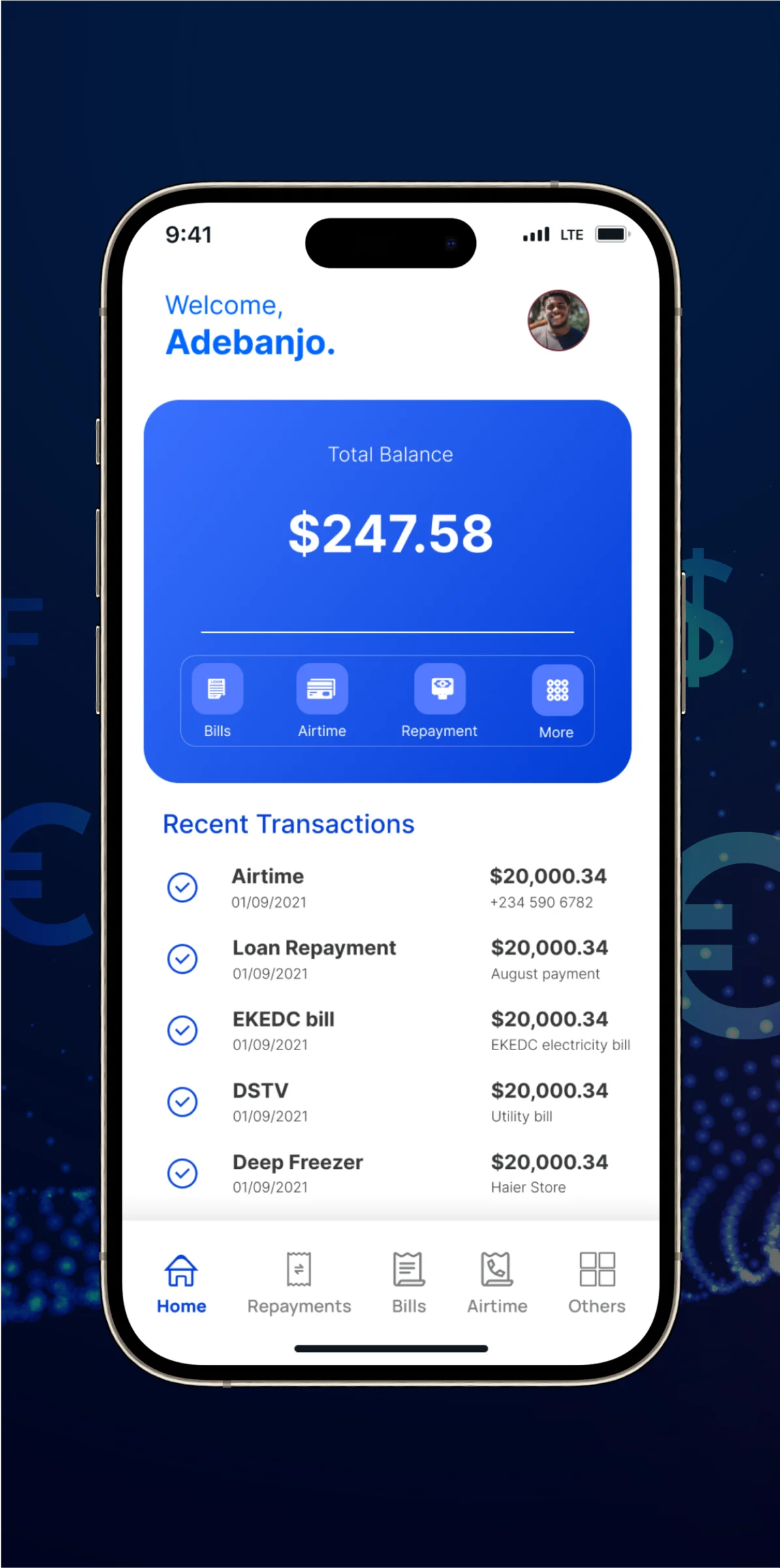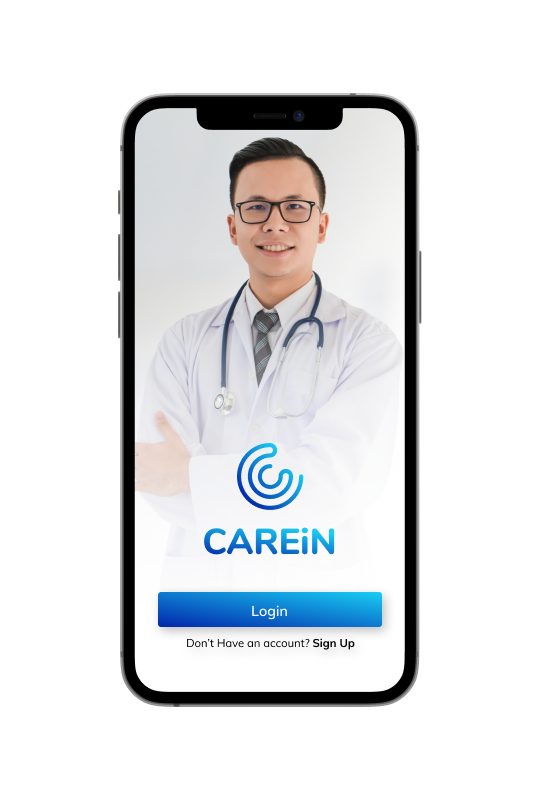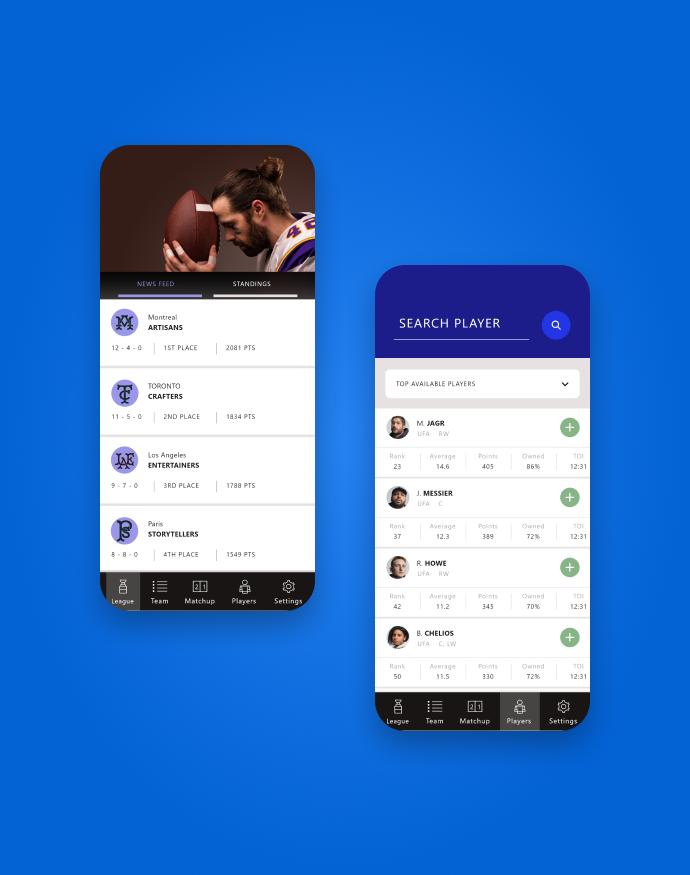- What Is A White-Label Telemedicine App?
- How Does A White Label Telemedicine App Work?
- Difference between White-Label Telemedicine Apps And Custom-Built Solutions
- Why Should You Invest In Building A White-Label Telemedicine Platform?
- Key Market Stats Of Telemedicine App
- Key Features Of White-Label Telemedicine Platforms
- Tech Stack For Building A Telemedicine App
- Step-by-Step Guide To Develop White-Label Telemedicine App
- Things To Be Considered Before Developing A White-Label Telemedicine App
- Cost-Affecting Factors Of Building A Telemedicine App
- Future Trends Of White-Label Telemedicine Platforms
- Top 5 White-Label Telemedicine Apps
- Conclusion
- How Ideausher Can Help
- FAQs

Telemedicine has emerged as a groundbreaking solution providing healthcare services at a patient’s comfort level. White-label telemedicine app development is a cost-effective and time-efficient approach to enter the market and revolutionize the way healthcare services are delivered. Embracing white-label telemedicine apps can provide innovative solutions, reduce time-to-market, extend the reach, and increase patient satisfaction. In this blog series, we will explore the benefits, features, challenges, and real-life case studies of white-label telemedicine app development.
- What Is A White-Label Telemedicine App?
- How Does A White Label Telemedicine App Work?
- Difference between White-Label Telemedicine Apps And Custom-Built Solutions
- Why Should You Invest In Building A White-Label Telemedicine Platform?
- Key Market Stats Of Telemedicine App
- Key Features Of White-Label Telemedicine Platforms
- Tech Stack For Building A Telemedicine App
- Step-by-Step Guide To Develop White-Label Telemedicine App
- Things To Be Considered Before Developing A White-Label Telemedicine App
- Cost-Affecting Factors Of Building A Telemedicine App
- Future Trends Of White-Label Telemedicine Platforms
- Top 5 White-Label Telemedicine Apps
- Conclusion
- How Ideausher Can Help
- FAQs
What Is A White-Label Telemedicine App?
A white-label telemedicine app is a customizable and ready-to-deploy solution allowing healthcare providers to offer telemedicine services under their brand. It is a cost-effective way to leverage technology to connect patients and healthcare professionals remotely.
With a white-label telemedicine app, healthcare providers can customize its features, design, and branding to align with their organization’s identity. This means that patients can access the app and receive virtual consultations, schedule appointments, exchange medical records securely, and even receive prescriptions, all using a platform that carries the healthcare provider’s branding. The white-label telemedicine app is developed by a third-party provider who specializes in building telemedicine software. This provider handles the technical aspects of developing and maintaining the app, while the healthcare organization focuses on delivering quality care to patients.
How Does A White Label Telemedicine App Work?
Here’s how a white-label telemedicine app works:
Branding Customization
A white-label telemedicine app allows healthcare providers to infuse their unique branding elements into the platform. This includes incorporating logos and selecting color schemes that resonate with the provider’s identity. This customization goes beyond functionality, offering a tailored visual experience that enhances patient recognition and trust in the virtual healthcare service.
Core Features
At the heart of the telemedicine app are essential features designed to streamline remote healthcare. Video consultations provide a real-time, face-to-face connection between healthcare professionals and patients, offering a comprehensive virtual care solution. The app’s appointment scheduling feature ensures efficient organization of virtual visits, optimizing resource utilization and improving overall operational efficiency. Secure messaging functionality establishes a confidential communication channel, allowing secure information exchange between patients and healthcare providers. The integration of Electronic Health Records (EHR) ensures a digitized and organized system for maintaining patient health records.
Patient Connectivity
The telemedicine app acts as a bridge, connecting patients with healthcare professionals in a virtual environment. Patients access the platform, fostering accessibility and convenience in healthcare delivery. User-friendly interfaces further enhance patient engagement, ensuring the virtual healthcare experience is seamless and intuitive for a diverse user base.
Real-Time Communication
The app supports real-time audio and video communication, enabling healthcare professionals to conduct thorough virtual consultations with patients. This real-time interaction replicates the immediacy of in-person visits, contributing to effective and personalized remote care.
Data Security and Compliance
Stringent security protocols are in place to protect sensitive patient data within the telemedicine app. Compliance with healthcare regulations, notably HIPAA, ensures that patient information remains private and confidential during virtual interactions. This commitment to data security reinforces patient trust in the virtual healthcare experience.
Integration with Existing Systems
Seamless integration with existing healthcare systems is a key feature of the telemedicine app. This integration ensures a cohesive and connected healthcare experience by linking with electronic health records and other databases. The result is a comprehensive and centralized repository of patient information, supporting a smooth transition to telemedicine while maintaining continuity in healthcare services.
Scalability and Flexibility
White-label telemedicine solutions are designed with scalability and flexibility in mind. The app’s architecture allows it to grow alongside the evolving needs of healthcare providers. The flexibility in design and functionality ensures adaptability to changes in healthcare landscapes and technological advancements, making the telemedicine platform a sustainable solution over time.
Difference between White-Label Telemedicine Apps And Custom-Built Solutions
| Aspect | Custom-Built Telemedicine Solutions | White-Label Telemedicine Apps |
| Approach | Meticulously crafted from the ground up | Streamlined approach for quicker market entry |
| Customization Level | High, tailored to specific and unique requirements | Limited, with predefined features and functionalities |
| Time and Resource Investment | Substantial time and resource investments | Minimal development hassle, expedited entry into the market |
| Flexibility | Unparalleled flexibility for specialized features | Limited flexibility, as features are predefined and standardized |
| Ideal for | Organizations with specific and unique telehealth needs | Clinics or startups seeking a rapid and cost-effective market entry |
| Advantages | Precise realization of the vision, shaping every aspect of the platform | Swift market entry, reduced development costs |
| Disadvantages | High time and resource investment | Limited customization, may not cater to highly specialized needs |
| Example Scenario | Telehealth startup targeting a specialized healthcare field | Clinic aiming for a quick and cost-effective entry into telemedicine |
| Key Differentiator | Bespoke features and tailored vision | The balance between market entry speed and bespoke features |
Why Should You Invest In Building A White-Label Telemedicine Platform?
Exploring white-label telemedicine platforms proves to be a forward-thinking investment as the healthcare landscape undergoes rapid transformation, necessitating a proactive approach to technology integration. Embracing this trend carries several compelling advantages, ensuring a strategic positioning in the evolving healthcare industry.
Enhanced Patient Engagement
White-label telemedicine platforms contribute to improved patient engagement by offering features like appointment reminders, real-time notifications, and personalized health information. This fosters a more active involvement of patients in their healthcare journey, leading to better adherence to treatment plans and increased overall health outcomes.
Data Security and Compliance
Investing in a reputable white-label telemedicine platform ensures robust data security and compliance with healthcare regulations. Adherence to standards such as HIPAA (Health Insurance Portability and Accountability Act) is crucial for safeguarding sensitive patient information. By choosing a well-established platform, healthcare providers can mitigate the risks associated with data breaches and legal non-compliance.
Expanded Accessibility
In the dynamic landscape of healthcare, mobile applications are reshaping patient interactions by transcending geographical constraints. Investing in a white-label telemedicine platform significantly extends the reach of medical services, enabling remote consultations that efficiently cater to a broader patient base. This not only elevates patient care but also enhances the prominence of healthcare brands.
Streamlined Administrative Processes
White-label telemedicine solutions come with integrated administrative tools that streamline processes such as appointment scheduling, billing, and medical record management. This automation reduces administrative burden, minimizes errors, and enhances overall operational efficiency for healthcare providers, allowing them to focus more on patient care.
Patient-Centric Care
The implementation of a white-label telemedicine platform fosters a shift towards patient-centric care models. By offering virtual consultations and remote monitoring, healthcare providers can tailor services to better suit the individual needs and preferences of patients. This patient-centered approach contributes to higher patient satisfaction and loyalty.
Reduced Technical Burden
The adoption of a white-label solution markedly alleviates technical complexities, eliminating the need for extensive technical expertise within your team. Entrusting the development to a specialized firm shifts the focus from intricate technicalities to strategic deployment and user acquisition. This approach streamlines app maintenance and updates, ensuring seamless operations. The result is the delivery of quality healthcare services through a professionally developed and consistently updated app, requiring minimal effort and investment.
Cost-Efficiency
Contrary to common perception, investing in custom white-label telemedicine solutions translates into significant cost savings for healthcare practices. The reduction in physical space requirements and the streamlining of administrative processes offset the development costs, contributing to substantial long-term savings.
Enhanced Convenience
A white-label telemedicine app enhances patient care by making health services easily accessible from any location. Through a few simple clicks, patients can schedule visits, consult with doctors, and receive prescriptions, eliminating the inconveniences of travel and wait times. This heightened user convenience and satisfaction contribute to an improved overall patient experience.
Analytics for Informed Decision-Making
White-label telemedicine platforms often come equipped with advanced analytics tools. These tools provide valuable insights into patient demographics, usage patterns, and other key metrics. Leveraging this data enables healthcare providers to make informed decisions, optimize service delivery, and tailor their offerings to meet the evolving needs of their patient population.
Global Reach and Market Expansion
By transcending geographical boundaries, a white-label telemedicine platform opens up opportunities for global reach. Healthcare providers can extend their services to underserved or remote areas, tapping into new markets and expanding their patient base. This global reach not only contributes to the growth of the healthcare practice but also positions the brand as a global player in the telemedicine landscape.
Competitive Distinction
Opting for white-label telemedicine platform development positions your app as a standout player in a crowded market. Providing a robust telemedicine service underscores your commitment to innovation, fostering patient retention and attracting tech-savvy consumers who seek modern solutions in healthcare.
Scalability
Custom-made telemedicine apps offer inherent scalability, adapting seamlessly to the growth of healthcare practices without the need for substantial investments in physical infrastructure. This flexibility allows for scaling up or down in response to patient flow, market trends, and evolving business needs, providing a strategic advantage for businesses aiming to flourish in the digital healthcare space.
Key Market Stats Of Telemedicine App
Source: Grand View Research
The estimated value of the worldwide telehealth market stood at USD 101.2 billion in 2023, with a forecasted compound annual growth rate (CAGR) of 24.3% from 2024 to 2030. The surge in demand for remote healthcare services, particularly in response to the COVID-19 pandemic, has significantly propelled market expansion. This upswing is attributable to the increased necessity for virtual consultations and remote monitoring during the pandemic. Entrepreneurs can tap into the thriving telehealth market by innovating in technology solutions, creating specialized service platforms, forming strategic collaborations, developing remote patient monitoring tools, and offering global consultancy services. The expanding demand for remote healthcare services, driven by the COVID-19 pandemic, provides ample opportunities for entrepreneurs to contribute and succeed in this dynamic industry.
Key Features Of White-Label Telemedicine Platforms
Creating a seamless and efficient virtual care experience hinges on incorporating essential features and functionalities into your white-label telemedicine application. These foundational elements contribute to operational excellence and an enhanced healthcare delivery ecosystem.
Telehealth Marketplace Integration
The inclusion of a telehealth marketplace within the white-label telemedicine platform allows users to access additional healthcare services seamlessly. This marketplace can feature third-party healthcare apps, wellness programs, or specialized consultations, offering users a comprehensive healthcare ecosystem in one unified platform.
Chatbot Assistance
Integrating a chatbot into the telemedicine app provides immediate assistance to users, answering common queries, guiding them through the platform, and facilitating a smoother user experience. This AI-driven feature enhances user engagement, reduces wait times, and complements the overall efficiency of the telehealth service.
Appointment Management
Efficient appointment scheduling is fundamental to a white-label telemedicine app. The platform should offer a user-friendly interface for patients to book, reschedule, or cancel appointments seamlessly. Intuitive systems that allow quick viewing of available time slots and easy appointment confirmation contribute to better time management for both patients and healthcare providers.
Real-Time Communication
High-quality video and voice calling functionality is a cornerstone of white-label telemedicine app development. This feature facilitates real-time consultations between patients and healthcare providers, ensuring a robust and user-friendly communication experience across various devices and networks.
Calendar Integration
Effective calendar integration is crucial for synchronization with personal calendars, providing reminders for upcoming appointments. This feature helps keep both patients and healthcare providers organized and punctual, supporting multiple calendar formats and offering real-time updates to prevent scheduling conflicts.
Notifications and Reminders
Timely notifications and reminders play a pivotal role in enhancing patient compliance. These features serve as personal assistants for health management, alerting patients to medication schedules, upcoming appointments, or follow-ups on treatment plans. Proactive engagement through notifications contributes to treatment continuity and improved health outcomes.
Telepsychiatry Capabilities
Specifically, tailored telepsychiatry capabilities enable mental health professionals to conduct virtual consultations, ensuring comprehensive healthcare coverage. This feature addresses the growing importance of mental health services and allows for secure and confidential remote consultations between patients and mental health professionals.
Prescription Management
Incorporating a prescription management system allows healthcare providers to generate electronic prescriptions efficiently during virtual consultations. This feature streamlines the prescription process, enhances medication management, and ensures that patients can access their prescribed medications conveniently through the app.
Automated Clinical Documentation
Incorporating automated clinical notes streamlines the documentation process for healthcare providers. This breakthrough feature ensures accurate and efficient capture of every patient interaction, essential for maintaining quality control, legal compliance, and better coordination of care among medical staff.
Secure Payment Processing
A secure payment gateway is a non-negotiable element in successful white-label telemedicine app development. Beyond processing payments, it instills confidence in patients regarding their data security. Compliance with industry standards like PCI DSS is imperative to protect sensitive financial information and ensure a seamless billing experience.
Electronic Health Records (EHRs)
Electronic health records (EHRs) form a foundational element, offering a comprehensive digital footprint of a patient’s medical history. EHRs enable physicians to track health changes over time, ensure medication accuracy, and seamlessly share critical information with patients and other healthcare professionals.
Cloud Storage Solutions
Reliable cloud storage solutions provide real-time data synchronization and remote access to patient information. This technology ensures the security of patient data against unauthorized access while making it readily available for medical consultations, aligning with the mobile-first preferences of today’s users.
Integrated Pharmacy Services
Integration with pharmacy services enables users to seamlessly order and receive medications directly through the telemedicine platform. This end-to-end solution enhances user convenience, improves medication adherence, and strengthens the connection between virtual consultations and practical healthcare actions.
In-App Language Interpretation
Facilitating in-app language interpretation ensures effective communication between healthcare providers and patients who may speak different languages. This feature removes language barriers, enhances accessibility, and promotes inclusivity, ensuring that every patient can fully engage with the telehealth services offered.
Multilingual Support
Multilingual support ensures accessibility to a diverse patient demographic, fostering better patient engagement, satisfaction, and potentially improved health outcomes. This feature significantly extends the reach and impact of health services, catering to patients from various linguistic backgrounds.
Administrative Dashboard
An administrative dashboard is critical for managing the complexities of telehealth services. It offers practitioners and healthcare administrators powerful tools for scheduling, reporting, and operational oversight. A well-designed dashboard streamlines processes, reduces administrative burdens and enhances the delivery of care by providing a comprehensive view of patient engagements and healthcare services management.
Security and Compliance Measures
Security and compliance are non-negotiable aspects of telemedicine application development. Incorporating advanced security protocols and ensuring compliance with healthcare regulations, such as HIPAA, safeguards patient data against breaches and unauthorized access. These features uphold the integrity of telehealth services and reinforce patient confidence in the digital healthcare system.
Augmented Reality (AR) for Anatomy Visualization
The incorporation of Augmented Reality (AR) for anatomy visualization brings a dynamic edge to telemedicine platforms. This technology allows patients and physicians to interact with 3D models of human anatomy, enhancing patient education by providing clear and interactive representations of complex medical conditions and procedures.
Post-Consultation Surveys
Implementing post-consultation surveys within the app allows patients to provide feedback on their virtual healthcare experience. This feature not only gauges user satisfaction but also provides valuable insights for continuous improvement, helping healthcare providers refine their services based on patient input.
AI-Powered Symptom Checker
An AI-powered symptom checker is an innovative tool that adds significant value to patient interactions. Analyzing symptoms and providing potential diagnoses, it assists patients in understanding their health conditions before consulting a healthcare professional. This functionality optimizes the care pathway and maximizes the efficiency of clinical staff, ensuring that initial patient contact is informative and directs them to the appropriate level of care.
Wearable Integration
Integrating wearables into telemedicine platforms allows for continuous monitoring of vital health metrics in real-time. This feature provides a wealth of data for preventive care and chronic disease management, enabling patients to share updates on heart rate, sleep patterns, and activity levels directly with their healthcare providers. It facilitates proactive health management and the creation of personalized care plans based on data collected from patients’ daily lives.
Tech Stack For Building A Telemedicine App
| Features | Description |
| Frontend | Framework: React Native or Flutter. |
| Backend | Language: Node.js or Python (Django/Flask).Database: MongoDB or PostgreSQL. |
| Real-time Communication | WebRTC: For video/audio.Socket.io: For real-time chat. |
| Cloud Services | Hosting: AWS or Google Cloud.Storage: Amazon S3 or Google Cloud Storage. |
| Security | SSL/TLS: Secure data in transit.HIPAA Compliance: Ensure healthcare data privacy. |
| Telemedicine Features | Video SDK: Agora or Twilio.Chat: Secure messaging system. |
| Authentication | OAuth 2.0: User authentication.JWT: Secure information exchange. |
| Payment | Stripe or PayPal: Transaction handling. |
| Compliance | HIPAA, GDPR: Adhere to healthcare regulations. |
| Monitoring | ELK Stack: Logging and monitoring. |
| Testing | Jest or Cypress: Unit and end-to-end testing. |
| Version Control | Git: Source code management. |
Step-by-Step Guide To Develop White-Label Telemedicine App
Here is a step-by-step guide on how to develop a white-label telemedicine app:
In-Depth Market Exploration and Strategic Blueprinting
Embark on the telemedicine app development journey by conducting thorough market research and crafting a robust strategic plan. Dive into understanding the healthcare needs of your target audience, analyze competing solutions, and stay abreast of emerging trends and telehealth regulations. Develop a unique value proposition, identify essential features, and ensure compliance with healthcare standards. Define your revenue model, considering options such as subscription services, freemium access, or per-transaction fees. Establish a realistic budget, timeline, and key performance indicators to guide the development process.
User-Centric Design and Prototyping
Place a strong emphasis on user-centric design during the telemedicine app development process. Create intuitive and user-friendly interfaces that cater to both patients and healthcare providers. Develop prototypes to visualize the app’s layout, functionality, and user flow, allowing for early feedback and refinement. Prioritize accessibility features to ensure usability for all users, including those with disabilities.
Scalability Planning
Anticipate future growth and demand by incorporating scalability into the development process. Design the architecture and infrastructure to accommodate increased user volumes, additional features, and evolving technology. This proactive approach ensures that the telemedicine platform can seamlessly expand to meet the needs of a growing user base and adapt to changes in the healthcare landscape.
Compliance and Security Protocol Establishment
Ensuring adherence to strict regulations like HIPAA and PHI is paramount in developing a secure white-label telemedicine solution. Implement robust encryption methods, enforce stringent access controls, and uphold patient consent procedures. Secure integration with Electronic Health Record (EHR) systems to maintain data integrity. Establish clear authorization levels and access policies, conduct regular risk assessments, and perform penetration testing to identify and mitigate potential vulnerabilities. Obtain the necessary clearances and licenses for telehealth operations.
Telehealth Integration Standards
Adhere to industry standards for telehealth integration to ensure compatibility with other healthcare systems and interoperability. Implement widely recognized standards such as HL7 (Health Level Seven) and FHIR (Fast Healthcare Interoperability Resources) to facilitate seamless data exchange between the telemedicine app and other healthcare applications, electronic health records, and medical devices.
Continuous Training and Support
Develop a comprehensive training program for both end-users and healthcare providers to ensure effective utilization of the telemedicine platform. Provide ongoing support through tutorials, documentation, and responsive customer service to address user queries and concerns. Continuous training and support contribute to user satisfaction, engagement, and the overall success of the telehealth solution.
Customization and Branding Integration
Tailor the telemedicine platform to meet specific operational needs through customization. Adjust the user interface to reflect the brand’s visual identity, incorporating color schemes, logos, and user experience elements. This process transforms the white-label solution into a unique asset, supporting specific services and integrating with existing systems for a seamless workflow. Ensure every aspect of the application aligns with the brand’s ethos to enhance user adoption and retention.
Analytics and Data Insights Integration
Incorporate robust analytics and data insights tools into the telemedicine platform to gather valuable information about user behavior, engagement, and platform performance. Analyze this data to make informed decisions, refine features, and optimize the user experience. Utilize data-driven insights to enhance the overall effectiveness and efficiency of the telehealth solution.
Continuous Compliance Monitoring
Establish mechanisms for continuous compliance monitoring to ensure that the telemedicine app aligns with evolving healthcare regulations. Regularly update security protocols, privacy measures, and data protection practices to address changes in compliance requirements. This ongoing commitment to compliance helps maintain the trust of users and safeguards the integrity of the telehealth platform.
Seamless Integration with Wearable Devices
Explore opportunities for seamless integration with wearable devices, allowing users to share real-time health data with healthcare providers. This integration enhances remote monitoring capabilities, providing valuable insights into patients’ health metrics. It also supports preventive care and chronic disease management by incorporating data from wearables into personalized care plans.
AI-Driven Personalization
Implement artificial intelligence (AI) capabilities for personalized user experiences. Leverage AI algorithms to analyze user data, preferences, and behaviors, enabling the platform to offer tailored recommendations, reminders, and content. AI-driven personalization enhances user engagement, adherence to treatment plans, and overall satisfaction with the telemedicine app.
Telemedicine Ecosystem Collaboration
Explore collaboration opportunities within the broader telemedicine ecosystem. Partner with pharmacies, diagnostic labs, and other healthcare service providers to create a comprehensive healthcare network. Integration with external services can offer users a holistic healthcare experience, from virtual consultations to medication delivery and diagnostic tests.
Testing, Launch, and Continuous Enhancement
Before launch subject the app to rigorous testing, covering usability trials and backend load tests to ensure optimal performance, reliability, and security. Roll out the application strategically, gathering initial user feedback for further refinement. Post-launch, focus on continuous improvement through ongoing enhancements and updates. Respond to user feedback and incorporate technological advancements to keep the telehealth software at the forefront of the rapidly evolving digital healthcare landscape.
Things To Be Considered Before Developing A White-Label Telemedicine App
Before embarking on the development of a white-label telemedicine app, careful consideration of various factors is crucial to ensure its success and effectiveness in the dynamic healthcare landscape. Here are essential aspects to ponder:
Regulatory Compliance
Thoroughly understand and adhere to regulatory frameworks governing telemedicine, such as HIPAA (Health Insurance Portability and Accountability Act) in the United States. Compliance ensures the protection of sensitive patient information and legal adherence, and fosters trust in your telemedicine solution.
Target Audience Analysis
Conduct a comprehensive analysis of your target audience. Understand their demographics, healthcare needs, and technological preferences. Tailor your telemedicine app to meet the specific requirements of the intended users, ensuring maximum adoption and engagement.
User Experience (UX) Design
Prioritize a seamless and intuitive user experience design. The app should be user-friendly for both healthcare providers and patients, with clear navigation, minimal friction, and accessibility features to accommodate diverse user needs.
Integration with Existing Systems
Consider seamless integration with existing healthcare systems, Electronic Health Records (EHRs), and other medical databases. Compatibility ensures a cohesive workflow for healthcare providers and facilitates the exchange of essential patient information securely.
Security Measures
Implement robust security measures to protect patient data and uphold privacy. Encryption, secure authentication, and stringent access controls are paramount. A secure telemedicine app instills confidence in users and mitigates the risk of data breaches.
Scalability Planning
Anticipate future growth and demand. Design the telemedicine app architecture to be scalable, accommodating increased user volumes and additional features. Scalability ensures the platform’s longevity and adaptability to evolving healthcare needs.
Customization Options
Ensure the white-label telemedicine app is customizable to meet the branding and operational needs of healthcare providers. The ability to customize logos, color schemes, and user interfaces enhances the app’s integration into the adopting organization’s identity.
Telehealth Feature Set
Carefully select and prioritize telehealth features based on the specific needs of users. Core functionalities such as appointment scheduling, video consultations, secure messaging, and prescription management should be robust and user-friendly.
Mobile Compatibility
Consider the widespread use of mobile devices and ensure the telemedicine app is compatible with various platforms (iOS, Android). Mobile compatibility enhances accessibility, allowing users to engage in virtual healthcare consultations from their smartphones or tablets.
User Education and Training
Develop comprehensive user education and training resources. Provide tutorials and documentation for both healthcare providers and patients to ensure they can effectively use the telemedicine app. Adequate training contributes to successful adoption and utilization.
Customer Support
Establish responsive customer support channels. Timely assistance for user queries, technical issues, or general inquiries is vital. Effective customer support enhances user satisfaction and builds trust in the telehealth solution.
Data Ownership and Portability
Clarify data ownership and portability policies. Users should have a clear understanding of who owns their healthcare data and the processes for transferring or accessing it. Transparent policies foster trust between users and the telemedicine platform.
Cost Considerations
Evaluate the overall cost of developing, deploying, and maintaining the telemedicine app. Factor in development costs, regulatory compliance investments, ongoing maintenance, and potential scalability expenses. A well-defined budget ensures financial sustainability.
Network Infrastructure
Consider the reliability of the network infrastructure supporting the telemedicine app. Robust network connections are essential to ensure stable and high-quality video consultations, reducing the risk of disruptions during virtual healthcare sessions.
Continuous Improvement Mechanism
Establish a framework for continuous improvement. Collect user feedback, monitor app performance, and iterate on features to address evolving healthcare needs and technological advancements. Continuous improvement ensures the telemedicine app stays relevant and effective over time.
By carefully considering these factors, you lay the groundwork for the successful development and deployment of a white-label telemedicine app that meets the needs of healthcare providers, patients, and the broader healthcare ecosystem.
Cost-Affecting Factors Of Building A Telemedicine App
Building a telemedicine app involves several factors that can influence the overall cost of development. Understanding these cost-affecting factors is crucial for planning and budgeting effectively. Here are key considerations that impact the financial aspects of developing a telemedicine app:
Complexity of Features
The complexity and scope of features integrated into the telemedicine app directly impact development costs. Basic features such as appointment scheduling and video consultations will have a different cost compared to more advanced functionalities like AI-driven symptom analysis, wearables integration, or augmented reality for medical visualization.
Platform Compatibility
The choice of platforms significantly affects costs. Developing a telemedicine app for both iOS and Android platforms increases development time and expenses. Alternatively, opting for cross-platform development frameworks may offer cost savings, but it’s essential to consider potential limitations and differences in user experience.
User Interface and Experience Design
Investing in a user-friendly and intuitive interface is crucial for a successful telemedicine app. The complexity and quality of design elements, such as user interfaces, graphics, and animations, can impact development costs. A well-designed and visually appealing app tends to require more resources and, consequently, a higher budget.
Compliance with Healthcare Regulations
Ensuring compliance with healthcare regulations, such as HIPAA in the United States, adds an extra layer of complexity and cost to development. Implementing robust security measures, encryption, and strict adherence to privacy standards are non-negotiable aspects that contribute to the overall development expenses.
Integration with External Systems
Integrating the telemedicine app with external systems, such as Electronic Health Records (EHR) or pharmacy services, can increase development costs. Seamless integration requires additional time and resources to ensure data interoperability and a cohesive user experience.
Customization and Branding
Customizing the app to align with a specific brand’s identity involves additional costs. This includes adjusting color schemes, logos, and other visual elements to create a unique and branded user experience. The extent of customization and branding requirements will influence the overall development budget.
Telehealth Ecosystem Collaboration
If the app involves collaboration with other healthcare service providers, pharmacies, or diagnostic labs, the development costs may increase. Creating a comprehensive telehealth ecosystem with seamless integrations and partnerships requires additional planning, resources, and potentially higher expenses.
Testing and Quality Assurance
Ensuring the reliability and security of the telemedicine app through thorough testing and quality assurance is essential. The more comprehensive the testing process, including usability testing, security testing, and performance testing, the higher the associated costs.
Maintenance and Updates
Post-launch, ongoing maintenance, and updates are necessary to address bugs, and security vulnerabilities, and incorporate new features. The cost of maintenance and updates should be factored into the overall budget to ensure the long-term sustainability and success of the telemedicine app.
Legal and Regulatory Consulting
Engaging legal and regulatory consultants to navigate the complex healthcare landscape and ensure compliance with local and international laws adds cost. This is crucial for avoiding legal issues and ensuring the app meets industry standards and regulations.
Future Trends Of White-Label Telemedicine Platforms
The landscape of telemedicine is undergoing rapid transformation, driven by technological advancements and a growing demand for remote healthcare solutions. To stay at the forefront of this evolution, it is crucial to anticipate the future trends shaping white-label telemedicine platforms. Here are some future trends in this niche:
Personalization as a Key Driver
The future of telemedicine platforms is marked by a shift towards personalized patient experiences. Individuals are increasingly seeking tailored healthcare solutions, and white-label telemedicine platforms must respond by incorporating features that enhance personalization. This includes the customization of care plans and the integration of AI tools for predictive health analytics, leading to more individualized and effective healthcare experiences.
AI Integration for Enhanced Analytics
Artificial Intelligence (AI) integration is a pivotal trend shaping the future of telemedicine platforms. AI tools are poised to revolutionize healthcare by providing advanced analytics and predictive capabilities. Telemedicine platforms with robust AI integration can offer personalized care plans, improved diagnostic accuracy, and more efficient healthcare delivery.
Blockchain for Data Security and Privacy
The adoption of blockchain technology is set to play a significant role in the future of telemedicine platforms. Blockchain promises enhanced data security and patient privacy, addressing critical concerns in the healthcare sector. By leveraging blockchain, white-label telemedicine platforms can establish a secure and transparent framework for managing patient data, fostering trust among users.
AR and VR in Remote Diagnostics
The impact of Augmented Reality (AR) and Virtual Reality (VR) in remote diagnostics is a notable trend on the horizon. These immersive technologies offer new possibilities for visualizing and diagnosing medical conditions remotely. Integrating AR and VR capabilities into telemedicine platforms enhances the diagnostic process, providing more comprehensive and accurate insights for healthcare professionals.
Interoperability for Seamless Data Flow
Interoperability is emerging as a focal point for the future of telemedicine platforms. Seamless data flow between different systems and devices is essential for comprehensive care management. Future platforms are expected to offer extensive device connectivity, ensuring that patient data is easily accessible and transferable across various healthcare systems.
Global Expansion and Multi-Language Support
The growth of telemedicine is transcending local boundaries, leading to the global expansion of healthcare networks. Future telemedicine platforms will need to adapt to this trend by offering multi-language support and cultural adaptability. This ensures that users worldwide can access and benefit from telehealth services, contributing to a more inclusive and accessible healthcare ecosystem.
5G Technology for Enhanced Connectivity
The advent of 5G technology will significantly boost telemedicine capabilities. Faster and more reliable connectivity means improved efficiency and responsiveness in telehealth services. The increased speed and bandwidth of 5G networks will facilitate real-time communication, high-quality video consultations, and enhanced remote monitoring capabilities.
Top 5 White-Label Telemedicine Apps
DocToDoor
DocToDoor provides a comprehensive telemedicine solution that includes remote patient monitoring and telemedicine consultations via a health app web platform. It is HIPAA-compliant and CE-class-certified. The platform can be white-labeled to match your brand.
Doxy.me
Doxy.me is a HIPAA-compliant telehealth platform that enables secure video calls, messaging, and file sharing between healthcare providers and patients. It is designed to be customizable and can be integrated with various health tech systems.
Zoom for Healthcare
Zoom for Healthcare is a telehealth platform that provides secure video calls, messaging, and file-sharing capabilities for healthcare providers and patients. It is designed to be HIPAA-compliant and can be integrated with various health tech systems.
Healthie
Healthie is a HIPAA-compliant telehealth platform that offers features such as video calls, messaging, file sharing, and health data management. It is designed to be customizable and can be integrated with various health tech systems.
SimplePractice
SimplePractice is a HIPAA-compliant telehealth platform that provides secure video calls, messaging, and file-sharing capabilities for healthcare providers and patients. It is designed to be customizable and can be integrated with various health tech systems.
Conclusion
In conclusion, white-label telemedicine app development offers a strategic and efficient solution for healthcare providers. This guide has outlined the key components, benefits, and the pivotal role these apps play in transforming healthcare delivery. Embracing this technology is not just a strategic move but a commitment to advancing healthcare accessibility and patient-centric services in the digital age.
How Ideausher Can Help
Embark on an exciting journey into the realm of White-Label Telemedicine App Development with us. At IdeaUsher, we specialize in cutting-edge Generative AI Solutions and Telemedicine Technology. Our dedication extends beyond technology; we’re committed to tailoring solutions that guide you through the intricacies of building a robust telemedicine platform. Our adept team endeavors to craft intelligent, user-centric apps, ensuring your venture takes a leading position in the dynamic telemedicine landscape.
Excited to explore the world of White-Label Telemedicine App Development? Click ‘Contact Us’ below to schedule a complimentary consultation and kickstart your journey today.
Contact Idea Usher
FAQs
Q: What is white-label telemedicine app development, and how does it differ from custom development?
A: White-label telemedicine app development involves creating a customizable, pre-built telemedicine platform that can be rebranded and resold by multiple clients. It provides a ready-made solution with basic features, allowing for faster deployment. In contrast, custom development involves building a telemedicine app from scratch, tailored to specific requirements, offering greater flexibility but requiring more time and resources.
Q: What are the key features to consider in a white-label telemedicine app?
A: Essential features for a white-label telemedicine app include secure video conferencing, appointment scheduling, electronic health records (EHR) integration, prescription management, and a user-friendly interface. Additionally, features like multi-platform accessibility, real-time chat, and payment integration contribute to a comprehensive and user-centric telemedicine solution.
Q: How can white-label telemedicine apps benefit healthcare providers and patients alike?
A: White-label telemedicine apps streamline healthcare delivery by providing convenient and accessible virtual consultations. Healthcare providers can expand their reach, reduce administrative burdens, and enhance patient engagement. Patients benefit from remote access to healthcare services, reduced travel time, and the ability to consult with healthcare professionals from the comfort of their homes.
Q: What are the challenges associated with white-label telemedicine app development?
A: Challenges may include ensuring compliance with healthcare regulations, addressing security and privacy concerns, and integrating the app with existing healthcare systems. Customization limitations can also be a challenge, as white-label solutions may not fully align with unique requirements. It’s crucial to choose a reputable development partner to navigate these challenges successfully.
Q: How can one ensure the security and privacy of patient data in a white-label telemedicine app?
A: Security measures such as end-to-end encryption, secure authentication methods, and compliance with healthcare data protection regulations (e.g., HIPAA) are paramount. Regular security audits, updates, and training for healthcare professionals using the app contribute to maintaining a robust security posture. Selecting a development partner with a proven track record in healthcare app security is essential for ensuring data protection.











